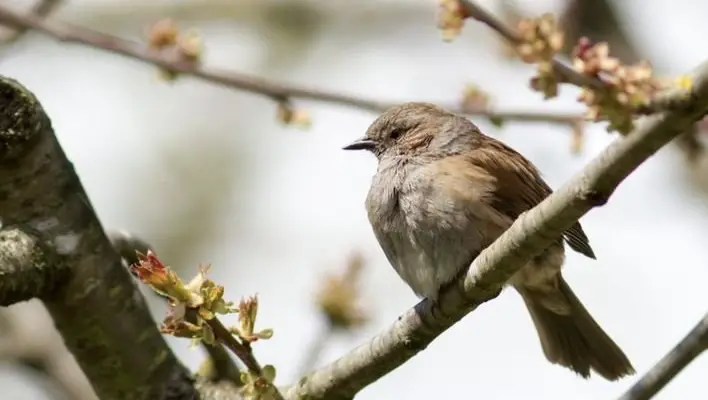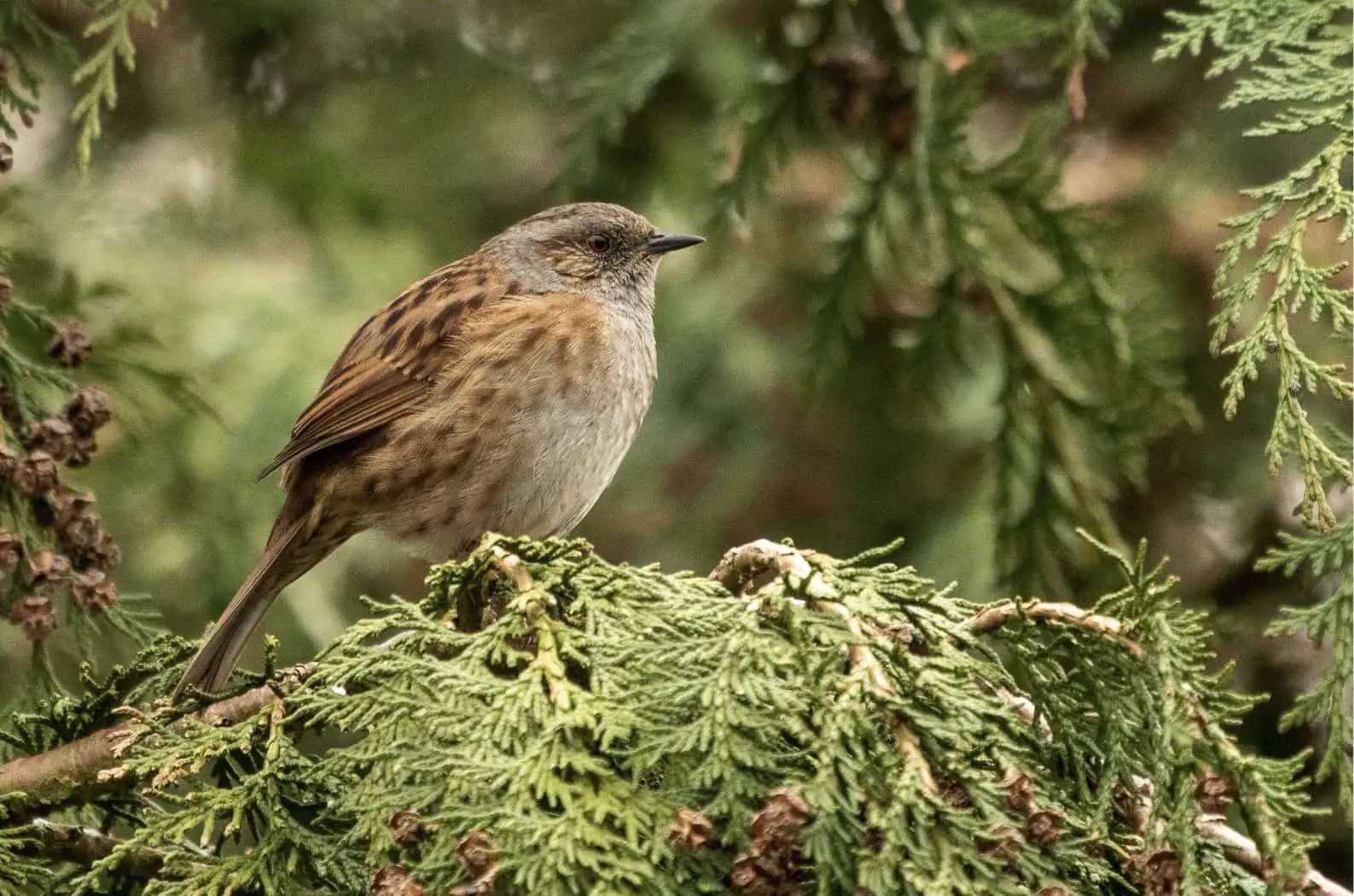Dunnocks are very shy and timid little passerine birds that are found throughout the British Isles. If you have walked in an area with hedgerows, you might have seen a little brown bird chirping around. More likely than not, you may have even mistaken it for a house sparrow. For all you know, it could have been an amber-listed bird called a dunnock. If you want to know more about where most dunnocks are in the UK, then you might want to continue reading.
About Dunnocks
Unless you look closely, it can be hard to tell a dunnock and a house sparrow apart because their physical differences are close to indistinguishable. The two weigh almost the same and display the same colours – warm tones and gray.
The dunnock’s scientific name is Prunella modularis, while the house sparrow’s scientific name is Passer domesticus. Right off the bat, we know that one and the other do not belong in the same family, let alone the same order. Although the dunnock is also known as the “hedge sparrow,” it is not considered a sparrow. Instead, it belongs to a family called the Accentors. Its name literally means little brown bird as it was derived from Old English.
Its length is 14-15 cm with a wingspan of 19-21 cm. Its weight usually ranges from 16-25 grams. When you see one from afar, its colour appears to be just brown, but when you get a closer look, you’ll see that it has a gray head and chest with some black streaks on the wings. Compared to the house sparrow, its bill is thinner and pointier.
Dunnocks feed on small invertebrates such as insects and some arachnids like ants and spiders. However, during the winter season, they feed themselves with berries and seeds.

Where Dunnocks Are Found in the UK
Almost 2.5 million pairs of dunnocks are found in the UK according to the team at BBC Wildlife Magazine. Currently, their conservation status in the UK is Amber which means that this species is of moderate concern in terms of its extinction in Europe. With The Wildlife and Countryside Act, these species are protected and are naturally found in habitats like woodlands, farmlands, grasslands, and in urban and suburban areas. With this being said, let’s map out where Dunnocks are found all over the United Kingdom.
1. Woodlands
When geographers attempt to describe a forest with trees that do not overlap, they call it forest woodlands. Sometimes, the woodlands are found in between two different ecosystems. As a forest, woodlands are full of trees and have an open space that provides the perfect environment for invertebrates, plants, and birds.
Let us put our minds into the dunnocks. As we have learned from our biology classes, one of the core themes of the subject is reproduction. Species reproduce. Birds need nests for them to lay their eggs and raise their little ones. These species usually make their nests in trees and bushes. So, of course, as dunnocks, they want the best for their offspring. They need an environment where there are a lot of possible locations to build a nest. Let’s also remember that woodlands are an environment where insects thrive, and insects are a huge portion of the dunnocks’ diet.
The latest woodlands statistics produced by Forest Research stated that the United Kingdom has 3.24 million hectares of woodland. They can be found all over England, Scotland, Wales, and Northern Ireland. So, if you were looking to see dunnocks for yourself, you can go to the North of England to places like Chesire, Cumbria, County Durham, Lancashire, Northumberland, and Yorkshire. You can also find them in the Midlands like West Midlands County, Shropshire, Staffordshire, Warwickshire, Worcestershire, and others. They can also be found in the East and Southeast of England with places like Essex, Bedfordshire, Suffolk, and Norfolk, and Buckinghamshire, Kent, Sussex, and Surrey respectively. There are also some in the southwest.
Some of the places where dunnocks can be found in Scotland are Angus, Argyll and Bute, Dumfries and Galloway, Fife, Stirling, and some other places in Scotland. There are also some in places in Wales like Caerfyrddin, Conwy, Gwynedd, Powys, and more. Parts of Northern Ireland also have Dunnocks around them.
2. Grasslands
A grassland is literally what it sounds like. A land full of open areas of grass, and sometimes with a few trees scattered around. A grassland is maintained with a low precipitation rate, wildland fires, and animal grazing. According to the website of Woodland Trust, 40% of the United Kingdom is covered by grasslands. So, you can literally find them anywhere in the UK.
Grasslands are a suitable environment for dunnocks. They feel safe and secure in this environment making it ideal for them to build their nests. A lot of insects also thrive in this habitat which makes hunting for food a lot easier.
If you are looking to find a dunnock in a grassland area in the United Kingdom, some of the many grasslands include Angel and Greyhound Meadow in Oxford, Beltingham River Shingle, Berryhill Fields, Brotheridge Green Nature Reserve, Burnfoot River Shingle, and Wydon Nabb, and Christ Church Meadow in Oxford. There are also Dunsdon National Nature Reserve, Hollybed Farm Meadows, Boynton Moss, Mill Meadows in Henley-on-Thames, Mottey Meadows, and North Meadow in Cricklade. Dunnocks can also be found in Port Meadow in Oxford, Portway Hill, Pulborough Brooks, Rackenford and Knowstone Moors, Runnymede, Warneford Meadow, Whitelee Moor, and Wolvercote Common.
3. Farmlands
We all know what a farm looks like unless you have been living in the big cities your whole life. Farmland is a piece of land where you can find livestock being raised and food grown. Most of them have the equipment to help farmers with their work. It is dedicated to doing the agricultural processes for food production and other crops.
With a place where growing food and plants is the main priority, species will definitely thrive here, including dunnocks. With the amount of food being produced, the habitat is enough for these adult birds to provide for their offspring. On farmlands, there are also trees where fruits grow. So, the creation of their nests is easy. Considering farmlands as a diverse habitat, dunnocks will absolutely enjoy their stay here.
Farmlands cover 72% of the United Kingdom, and just like grasslands, you can find them anywhere, especially in rural locations. The farmlands in the UK measure 17.6 million hectares, and the UK measures about 24.2 million hectares. So, imagine that you can drive a little bit to a rural area wherever you are in the UK to hunt for the amber-listed dunnock birds.
4. Urban and suburban areas
Aside from the locations we have talked about above, dunnocks can also be seldomly seen flying around urban and suburban areas anywhere in the United Kingdom, especially with very dense vegetation. These areas may be close to the habitats we discussed earlier. So, if you’re lucky enough to be in an area close to where dunnocks thrive, then you can just go outside and look for the little brown birds.
Conclusion
In the UK, you can find the dunnocks all year round in areas like woodlands, grasslands, and farmlands, and rarely in urban and suburban areas. They can be found in the North, East, Southeast, and Midlands of England. They can also be seen in some parts of Scotland, Wales, and Northern Ireland.
The amber-listed birds can be found in places with rich vegetation and a diverse ecosystem. For them to lay their eggs and feed their offspring, they prefer places where they can build their nests and where they can get lots of insects and seeds as their food. If you’re in an area that has a lot of trees, bushes, and other vegetation, you might be able to spot one of these little birds!
You May Also Be Interested In…
- 4 Places To Spot Dunnock Birds
- How Long Does It Take For Dunnocks To Fledge
- What Can I Feed A Dunnock
- Where Do Dunnocks Go In Summer
- Dunnock Or Sparrow? 7 Key Differences Between Dunnocks & Sparrows
- How Common Are Dunnocks
- Where Do Dunnocks Roost
- What Bird Family Is The Dunnock? Everything You Need To Know About Dunnocks
- Do Dunnocks Use Nestboxes
- Why Do Robins Chase Dunnocks? Garden Birds & Territoriality
- The Life-Cycle Of Hedge Sparrows (Dunnocks)
- What Do Dunnocks Eat? How To Feed Dunnocks In Your Garden

